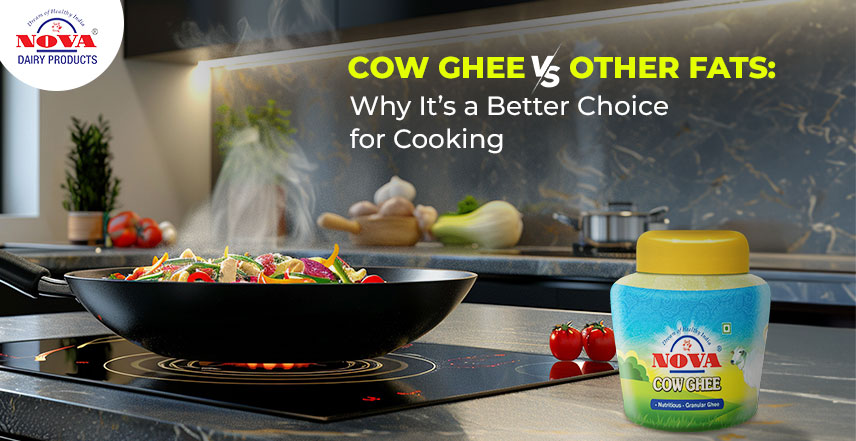Ever wondered why Indian food smells so amazing? A big part of that magic is Desi Ghee has been a staple ingredient in Indian kitchens for ages. It’s got a rich, nutty flavor and a delightful aroma that can elevate any dish. It’s packed with potential health benefits and has a unique set of properties that make it a standout ingredient. Though there is constant dilemma that it is better than the other fats used while cooking. But is it really better than other cooking fats? Let’s dive into the ghee debate and find out!
The Health Benefits of Ghee
- Nutrient-rich: Ghee is a good source of fat-soluble vitamins like A, D, E, and K, essential for various bodily functions.
- Antioxidant-packed: It contains antioxidants that help neutralize harmful free radicals, reducing the risk of chronic diseases.
- Digestive aid: Ghee promotes the secretion of digestive enzymes, aiding in better absorption of nutrients.
- Immune system support: The butyric acid in ghee can help strengthen the immune system.
- Joint lubrication: Ghee has been traditionally used to lubricate joints and improve mobility.
Why Ghee is a Superior Cooking Fat
Ghee, a clarified butter, has been used in Indian cuisine for centuries due to its unique properties and health benefits. Unlike regular butter, ghee has had its milk solids removed, making it a more stable and flavorful cooking fat. This guide will explore why ghee is considered a superior choice for cooking compared to other fats.
- High smoke point: Ghee can withstand high temperatures without breaking down or producing harmful compounds like trans fats. This makes it ideal for frying, sautéing, and grilling.
- Neutral flavor: Unlike butter, ghee has a neutral taste, allowing the flavors of your food to shine through.
- Long shelf life: Ghee can last for months or even years when stored properly, making it a convenient pantry staple.
- Lactose-free: Ghee is clarified butter, so it’s free from lactose, making it suitable for those with lactose intolerance.
Ghee vs. Other Fats: A Nutritional Comparison
Ghee, a clarified butter, has gained popularity in recent years for its potential health benefits and unique flavor. However, how does it stack up against other common fats? Let’s dive into a nutritional comparison.
Ghee is made by heating butter until the milk solids separate and are removed, leaving behind pure butterfat. This process gives it a higher smoke point than regular butter, making it suitable for high-heat cooking. Ghee is also rich in butyric acid, a short-chain fatty acid linked to potential benefits for gut health.
Ghee vs. Butter
- While ghee and butter share a common origin, they differ in their nutritional composition. Ghee has a higher saturated fat content than butter, which can be a concern for those watching their cholesterol intake. However, ghee is lactose-free, making it a suitable option for individuals with lactose intolerance.
Ghee vs. Coconut Oil
Coconut oil is another popular cooking fat known for its high saturated fat content. While both ghee and coconut oil have high smoke points, coconut oil has a distinct flavor that may not be suitable for all dishes. Coconut oil also contains medium-chain triglycerides (MCTs), which can be metabolized differently than long-chain triglycerides found in ghee.
Ghee vs. Olive Oil
Olive oil is often praised for its heart-healthy properties due to its high monounsaturated fat content. While olive oil is generally considered a healthier choice than ghee or coconut oil, ghee’s higher smoke point makes it a better option for high-heat cooking.
Ghee and Mustard oil
- Ghee and mustard oil, both staples in Indian cuisine, offer distinct flavors and nutritional profiles. Ghee, a clarified butter, boasts a high smoke point, making it ideal for high-heat cooking. Its neutral taste and lactose-free nature make it versatile, suitable for various dishes. Mustard oil, on the other hand, has a pungent aroma and flavor, commonly used for tempering and cooking vegetables. While it contains erucic acid, which can be harmful in excess, moderate consumption offers potential health benefits.
Ghee and Sunflower oil
- Ghee is a clarified butter with a neutral flavor and high smoke point, making it suitable for high-heat cooking. It is lactose-free and has a higher saturated fat content than butter. Sunflower oil is a vegetable oil extracted from sunflower seeds. It has a neutral flavor and a moderate smoke point. Sunflower oil is rich in polyunsaturated fats, particularly linoleic acid, which is essential for good health.
The choice between ghee and other fats depends on individual dietary needs, preferences, and cooking requirements. Ghee’s higher smoke point, unique flavor, and potential gut health benefits make it a versatile option. However, its high saturated fat content should be considered, especially for individuals with heart health concerns. To ensure your diet is tailored to your specific needs, it’s crucial to seek advice from a healthcare professional or registered dietitian.
See Also: Quick and Easy Dal Tadka Recipe Using Cow Ghee
Conclusion
So, there you have it! Ghee is not just a delicious ingredient, but also a nutritional powerhouse. Its high smoke point, neutral flavor, and potential health benefits make it a standout choice for cooking. Whether you’re frying, sautéing, or baking, ghee can add a touch of magic to your dishes. It’s a versatile ingredient that can enhance the flavor of both sweet and savory dishes. So, the next time you’re cooking up something delicious, give Nova ghee a try. You won’t be disappointed!

